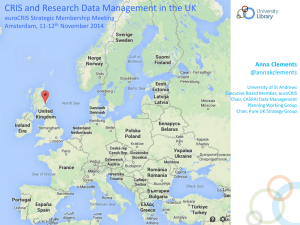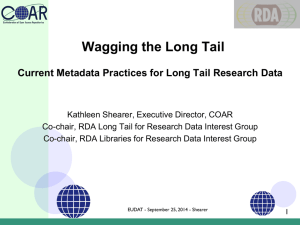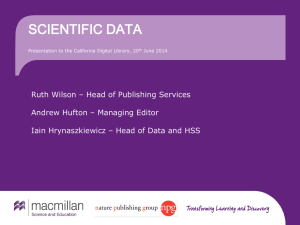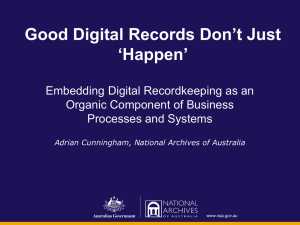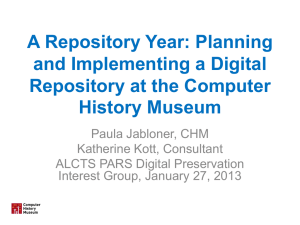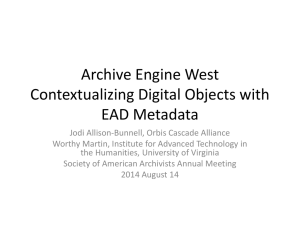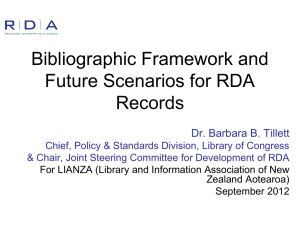PowerPoint-Präsentation - Datacite Annual Conference
advertisement
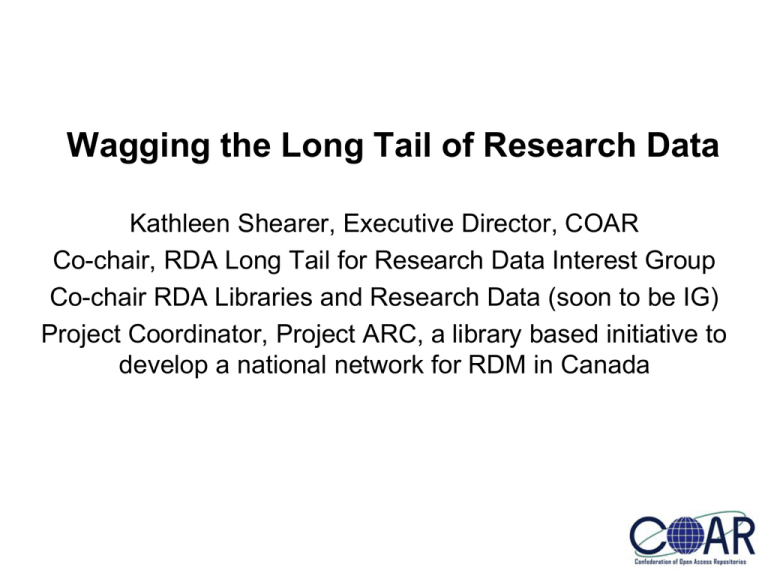
Wagging the Long Tail of Research Data Kathleen Shearer, Executive Director, COAR Co-chair, RDA Long Tail for Research Data Interest Group Co-chair RDA Libraries and Research Data (soon to be IG) Project Coordinator, Project ARC, a library based initiative to develop a national network for RDM in Canada About The Confederation of Open Access Repositories (COAR) • Over 100 institutional members from around the world on five continents • Mission: to create a global network of open access repositories in support of research • Community of practice & an international voice for the OA repository community • Major issue is interoperability (repository-repository AND repository-other systems) • To date, mainly focused on institutional role in managing and providing open access to publications • These services are evolving/expanding to include the management of research data “Big data” is all the rage But, the majority of datasets produced through research are part of the “Long Tail of Research Data” (Image from Chuck Humphrey: OpenAIRE-COAR Conference, Athens 2014) Characteristics of Long Tail Research Data Head Tail Homogeneous Heterogeneous Large Small Common standards Unique standards Integrated Not-integrated Central curation Individual curation Disciplinary repositories Institutional, general or no repositories Adapted from: Shedding Light on the Dark Data in the Long Tail of Science by P. Bryan Heidorn. 2008 Long Tail of Research Data: small (…sometimes) The 2011 survey by Science, found that 48.3% of respondents were working with datasets that were less than 1GB in size and over half of those polled store their data only in their laboratories. Science 11 February 2011: Vol. 331 no. 6018 pp. 692693 DOI: 10.1126/science.331.6018.692 Long Tail of Research Data: heterogeneous • A review undertaken by Cornell University of over 200 data “packages” (files related to arXiv papers) deposited into the Cornell Data Conservancy with there were 42 different file extensions for 1837 files across six disciplines. http://blogs.cornell.edu/dsps/2013/06/14/arxiv-data-conservancy-pilot/ • The Dryad Repository, which is a curated, general-purpose repository that collects and provides access to data underlying scientific publications reports a huge diversity of formats including excel, CVS, images, video, audio, html, xml, as well as “many uncommon and annoying formats”. The average size of the data package which they collect is ~50 MB. http://wiki.datadryad.org/wg/dryad/images/b/b7/2013MayVision.pdf • According to the European Commission (EC) document, Research Data eInfrastructures: Framework for Action in H2020, “diversity is likely to remain a dominant feature of research data – diversity of formats, types, vocabularies, and computational requirements – but also of the people and communities that generate and use the data.” http://cordis.europa.eu/fp7/ict/einfrastructure/docs/framework-for-action-in-h2020_en.pdf Long Tail of Research Data: Institutional, general, domain or (often) no repositories Science 11 February 2011: Vol. 331 no. 6018 pp. 692-693 DOI: 10.1126/science.331.6018.692 Long Tail of Research Data: some of the challenges Data quality - Determining quality and value of datasets - Standards, metadata and norms differ significantly across disciplines Discoverability - diverse datasets are less discoverable because they are not found in a “go to” domain repository Incentives -why should researchers for deposit their data? Business case - why should organizations invest in the management of this data? Long Tail of Research Data Interest Group • Accepted as an RDA Interest Group in Summer 2013 • Over 90 members from around the world Objectives • To better understand the long tail • To address some of the challenges involved in managing diverse datasets • To share current practices, and develop best practices, for managing diverse data • To work towards greater interoperability across repositories Long Tail of Research Data Interest Group Activities-to-date • Survey of discovery metadata • Discussion of strategies for improving discoverability of datasets (All information is available on the interest group’s website) Future activities • evidence to incentivize researchers to deposit • creating environments to make it easier for researchers to deposit their data, • sharing practices about discovery, • interoperability across repositories • preservation planning Survey of Current Practices for Discovery of Research Data Survey of Current Practices for Discovery Metadata • Purpose: to better understand the current practices in terms of discovery metadata • Respondents: any repository collecting long tail data • Undertaken from February 15 to March 7, 2014 • Recruited respondents via RDA mailing list and other research data list serves • Over 60 responses, but only 30 full responses • OBVIOUSLY not a representative sample, but an indication of which way the wind is blowing Location of repository Country of where instituton that manages the repository is located United States United Kingdom Spain Canada Australia France Switzerland Netherlands Lithuania What are the descriptive metadata standards used? Repositories using a single schema Dublin Core (9) DataCite (3) DDI Study-level metadata cf supra. ISO19115 (Geographic Information Metadata) MARC21 MODS metadata RIF-CS Repositories using more than one schema DataCite and Dublin Core (3) Dublin Core, Darwin Core, Prism Dublin Core, EDM, ESE, QDC Dublin Core, MARC21 dc, dcterms, geo/wgs84, FOAF, own extension ontology MODS & DataCite Metadata Schema Organic.Edunet IEEE LOM In your opinion, is the metadata used in the repository sufficient to ensure discoverability of the datasets? 88% said yes, but… • Broadly speaking, and at a very high level, yes. If someone is looking for the data that supports a specific study, it is likely they will find it. However, if someone is looking for data with specific collection characteristics or other particularities then the metadata requires further enhancement. • We aim to index metadata to aid discovery only. Metadata required to explore / reuse data will be stored with the data as a (non-indexed) object or stored in a separate, searchable database which links to the individual data objects in the repository (which may be at a sub-collection level). Data will also be found as the DOI will be included in publications related to the dataset. In your opinion, is the metadata used in the repository sufficient to ensure discoverability of the datasets? 88% said yes, but… • Data are discoverable within the repository because of limited repository scale, but once harvested and made available to search alongside tens of thousands of other datasets, the metadata are insufficient • Precision is low because natural language metadata queries tend to entrain marginally relevant data sets due to weak associations in project descriptions and other broad fields. • Fine for basic discoverability - richer discipline metadata would be nice but probably not feasible at this point But we know, most most people use Google as their discovery tool Strategies for improving the discoverability of datasets • Linking data to publications • Data citation- DOIs • Build discovery layer that further describes data (landing pages) • Attach or link to Data Management Plans (DMPs) • Enable machine readability • Data sets registries • Data repository registries Some concluding comments • There is a growing interest in the management of long tail research data and institutions are recognizing they have a responsibility to manage research data • Institutions can offer a sustainable, long-term solutions • We already have a lot of expertise with metadata, preservation, and collaboration • But, we need to work closely with data creators who have the disciplinary knowledge • We have a lot to learn from the disciplinary communities about managing data • We should heed the lessons learned from academic publishing (i.e. be wary of artificial measures of quality and impact) kathleen.shearer@coar-repositories.org

